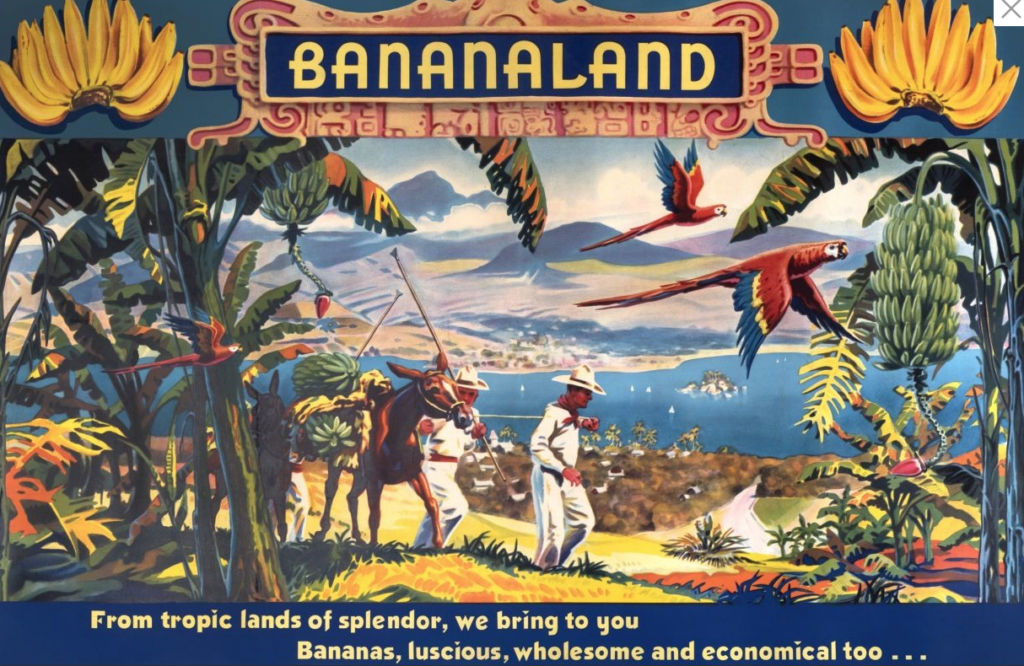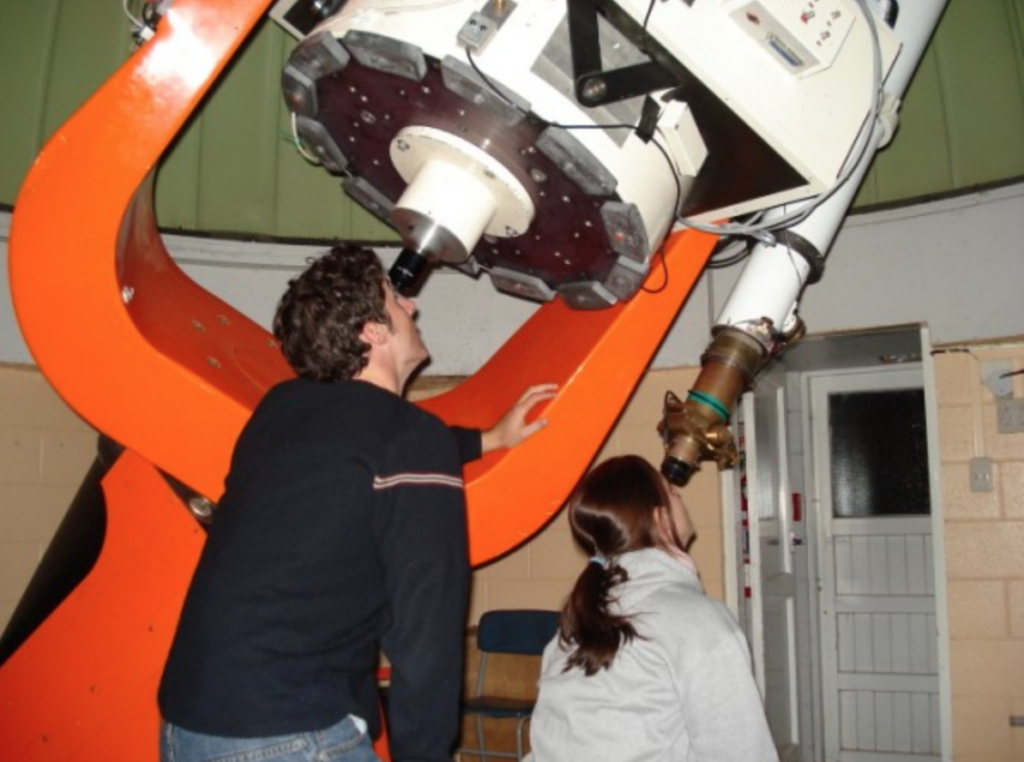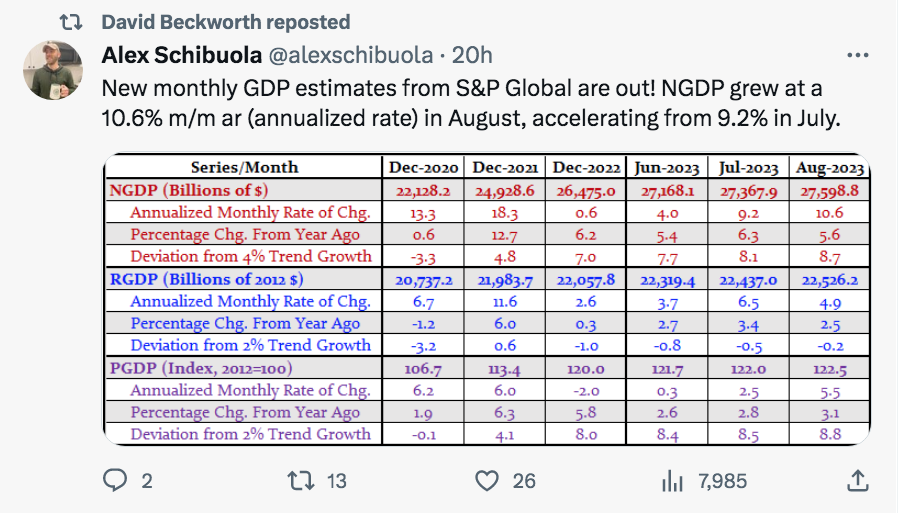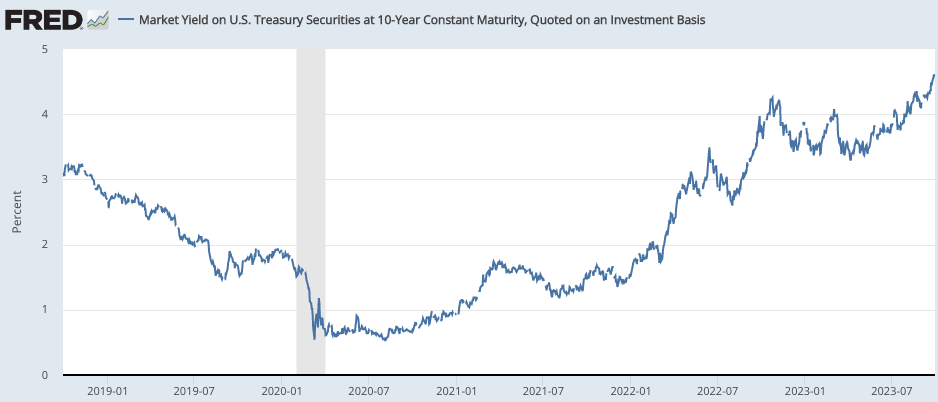8.5%
NGDP growth. Do I even need to comment?
(Supply shocks? I don’t think so.)
PS. The Atlanta Fed keeps winning.
A slightly off-center perspective on monetary problems.
NGDP growth. Do I even need to comment?
(Supply shocks? I don’t think so.)
PS. The Atlanta Fed keeps winning.
There is no good argument for the NeoFisherian claim that rising nominal interest rates represent an expansionary monetary policy. But if forced to defend that position I would focus on long-term interest rates. That’s one area where the NeoFisherians are usually correct. Long-term rates are more likely to reflect the condition of the economy (expected NGDP growth), while short-term rates are more likely to reflect the liquidity effect of monetary policy.
I think it’s safe to assume that SF Fed President Mary Daly is not a NeoFisherian:
San Francisco Fed President Mary Daly said that recent rises in bond yields were akin to a rate hike.
Daly said increasing bond yields showed that financial conditions were tight, “diminishing” the need for further Federal Reserve interest rate hikes.
Milton Friedman had a very different view:
Low interest rates are generally a sign that money has been tight, as in Japan; high interest rates, that money has been easy. . . .
After the U.S. experience during the Great Depression, and after inflation and rising interest rates in the 1970s and disinflation and falling interest rates in the 1980s, I thought the fallacy of identifying tight money with high interest rates and easy money with low interest rates was dead. Apparently, old fallacies never die.
Nick Rowe has suggested that one argument against NeoFisherism is that Keynesian central bankers seem to know which way to turn the steering wheel. After all, inflation in places like the US and Canada has averaged about 2% since 1992. That’s probably not a coincidence.
But it’s worth noting that central banks don’t always get it right. And some of their biggest policy errors occurred during the 1960s and 1970s, when they assumed that monetary policy was contractionary because interest rates were high.
God help us if the Fed views rising long-term interest rates as a reason not to tighten monetary policy.
PS. That’s not to say we necessarily need tighter money—a debatable point. But rising bond yields are not a reason to be complacent.
Ross Douthat has a good piece on structural problems with the US political system (and, I would add, many other countries.)
To grow in age is supposedly to grow in wisdom, and in theory one might imagine that what an aging society lacked in dynamism and innovation, it would make up for in the sobriety and seriousness of its leaders.
Instead in our would-be presidents we see the weaknesses of age — the debilitation of Joe Biden, the instability of Donald Trump, even the paranoia of their potential third-party challenger, Robert F. Kennedy Jr. (who if elected would be the second-oldest American to begin a first presidential term).
While in our younger leaders, instead of counteracting virtues, we have chaotic vices that threaten to make everything ungovernable — the Republican Party, the House of Representatives, the country as a whole.
But this is not accurate:
The irony is that in that moment Trump was mostly right on the merits: Neither 2012 nor 2016 was an ideal time for fiscal retrenchment, given the sluggish comeback from the Great Recession and the resilience of low interest rates.
We accomplished substantial fiscal retrenchment in late 2012, and the economic recovery actually sped up. By 2016, we were already raising interest rates. Fiscal retrenchment would have been an ideal policy at that time.
Now we are a banana republic and it’s too late to fix the fiscal mess. I’m afraid we need to expect some really bad news in the years ahead. Banana republics don’t end well.
Years ago, I was a contrarian when I claimed we were becoming a banana republic and our fiscal situation was out of control. Now both claims are close to conventional wisdom.
[Of course the Washington clown show is great news for Vladimir Putin. Now he can look to the future with increased optimism.]
PS. I’ve sort of come around to Trump’s view of things. Back in 2016, I was skeptical of his claim that we should “lock up” government officials who were sloppy with classified material. Use of a private email didn’t seem like that big a deal. But giving away secrets regarding our nuclear subs? Yeah, I can kind of see how Trump might be correct. Lock them up.
I am also coming around to his view that it’s outrageous when a president’s child earns vast sums of money from foreign entities trying to curry favor with the president.
He’s also correct about it being a big mistake to elect a president who is old and senile.
Strange new respect—we share more and more opinions.

Over the past few years, I’ve searched and searched for that tight money everyone keeps talking about:

Instead, I keep stumbling across data points like this:

OK, that’s just a forecast. It’s not like the financial markets are worried about NGDP growth.
Oh wait:

And it’s up another 20 basis points today (not shown.)
This past quarter I went on a Hal Hartley binge—interesting director. I also read Chateaubriand’s autobiography (1300 pages, up to 1815), which I loved. Saw the Succession TV series, which has all the strengths and weaknesses of other “quality” TV series. Works best as a black comedy—can be cringeworthy when the writers start taking themselves seriously.
2023:Q3 films
Newer Films:
Lynch/Oz (US) 3.9 So far, this is my favorite film of the 2020s. Six essays exploring links between The Wizard of Oz and the films of David Lynch (and to some extent cinema more broadly.) Five of the six are outstanding—and deeply enjoyable. This increased my already sky high view of both Oz and Lynch. See it on the big screen.
Close to Vermeer (Dutch) 3.5 As a documentary, this is merely good. But the images of Vermeer’s painting are the best I’ve ever seen on film—perhaps even better than in real life. I wish they’d spent more time lingering over each masterpiece.
Barbie (US) 3.3 Pretty if you like pink. Amusing at times. A good film, but I’m not the intended viewer—the humor is dumbed down for the teenage audience. I kept looking at my watch. (BTW, Amazon charges $25 for a rental. A Chinese station shows it for free.)
MI: Dead Reckoning (US) 3.0 The actors have gotten old, the ideas are old, and I’m too old for this sort of film. (Tom Cruise has lost his charisma—his face seems bloated from plastic surgery, or botox, or old age.) Everything was derivative. The handcuffed couple was done better in The 39 Steps. The car chase was done better in Bullet. A rogue AI was done better in 2001. A runaway train was done better in The General. Mysterious Venice at night was done better in Don’t Look Now. A terrorized submarine crew was done better in Das Boot. Defusing a bomb was done better in Goldfinger (and even better in The Small Locked Back Room.) It’s a film by committee.
This was my first time in a 4DX theatre. Imagine the worst thunderstorm you ever flew through on an airplane, and then stretch that out for 3 hours. The seats were continually jerking this way and that, and wind and water spray added to the effect. I can only imagine what sort of experience will be added to viewers of XXX movies in the year 2123. Sensory immersion seems sort of like 3-D films—a good idea that somehow doesn’t work out in reality.
Older Films:
Taste of Cherry (Iran, 1997, CC) 3.9 My all-time favorite Iranian film (and there’s a lot of great competition.) The 1990s was the golden age for the sort of film that initially seems devoid of a clear narrative, but in some hard to discern way end up being far more engrossing than standard Hollywood fare. These films typically came out of non-Western countries such as Iran, China, Taiwan, Turkey and Mexico.
Onibaba (Japan, 1964, CC) 3.9 The riches of mid-century Japanese cinema seem almost inexhaustible. No matter how many films you’ve seen, there’s always another masterpiece to be discovered. William Friedkin was asked to name his all time favorite films and this one was first on his list. Yes, Friedkin and I probably overrate Onibaba, but it’s such a pleasure to be reminded of the frisson I used to experience at the cinema.
Letter Never Sent (Russia , 1960, CC) 3.9 I liked this even more than the director’s more famous “Cranes are Flying”. Great B&W cinematography. Made the same year as Psycho, L’Avventura, The Apartment, Peeping Tom, Breathless, La Dolce Vita, When a Woman Ascends the Stairs, Late Autumn, The Naked Island, The Bad Sleep Well, Purple Noon. Every month a new masterpiece.
Pigs and Battleships (Japan, 1961, CC) 3.8 As with Martin Scorcese, Imamura has a great feel for small-time hoodlums. But Imamura is more sarcastic, and has a more flamboyant visual style. And there’s no Catholicism lurking in the background. Life is what it is—only the strong survive.
The Graduate (US, 1967, CC) 3.8 It’s easy to recall the great dialogue and the excellent soundtrack, but I had forgotten just how good the visuals were. Criterion had a print that looked as good as the day it premiered, and Mike Nichols created a number of really striking images. Is this the film that best captures the feel of the 1960s?
Oldboy (Korea, 2003) 3.8 This is the film that best epitomizes the way Korean movies frequently dial up the intensity level to an eleven. Rewatching Oldboy after 20 years, I found the style every bit as powerful as the first time, but the surprises were no longer as shocking and the extreme violence was quite unpleasant to watch.
Floating Weeds (Japan, 1959, CC) 3.7 Ozu remade the 1934 version, entitled The Story of Floating Weeds.
Z (French/Greek, 1969, CC) 3.7 This film had a big impact on me back in 1969. After 54 years it’s easy to spot the flaws, but it remains a powerful and highly influential film. (With a more subtle and thoughtful director it could have been a 4.0 film.) Essential viewing for anyone who wishes to understand the sociology of fascism. In 1969, Greece, Spain and Portugal were still ruled by quasi-fascist regimes. A few years later they were all democracies. The symbol “Z” has gone from an emblem of hope in 1969 to a symbol of Russian fascism in 2023. What a sad time we live in.
Dersu Uzala (Russia/Japan, 1975, CC) 3.7 Kurosawa is viewed as the most “Western” of the great Japanese directors, and perhaps that’s why he was able to make a successful Russian film. The first half is brilliant—the second half is merely good. Unfortunately, as with many 1970s color films, the print is in need of restoration.
Black River (Japan, 1957, CC) 3.7 There’s a lot to appreciate in this Kobayashi film, including the engrossing portrayal of post-war Japanese life near a US military base. Some excellent B&W cinematography. Great final scene.
Henry Fool (US, 1997, CC) 3.7 Excellent independent film from the 1990s.
Meanwhile (US, 2011, CC) 3.7 A beautiful exercise in minimalism. Hartley is one of our most intelligent directors
Lola (France, 1961, CC) 3.6 In Demy’s film the characters seem to float though life in a sort of dream, both pleasant and sad. Why can’t Anglo-Saxon directors refrain from judging everyone in such a tiresome manner?
Saturday Fiction (China, 2019, CC) 3.6 I understand why this film got mixed reviews, but I found the positives to be so strong that I didn’t much care about the confusing plot. As usual, Gong Li is superb (and the other actors are excellent.) The B&W cinematography is gorgeous. Because we often get foreign films with a long delay, we miss the “golden ages” until they are over. The period around 2018-19 brought us Ash is the Purest White, Long Day’s Journey Into Night, An Elephant Sitting Still, Wild Goose Lake, and this film. What else did I miss?
Suzhou River (China, 2000, CC) 3.6 Basically a Chinese version of Vertigo. Interesting to see how grungy Shanghai looked back in 2000.
Ghost World (US, 2001, CC) 3.6 I gather that this was not popular at the box office but I loved the performance of the lead actress (Thora Birch), which explains my high rating. Brought back memories of when I was an anti-social adolescent. Also features a very young Scarlett Johansson. Otherwise, the film is nothing special.
Desperately Seeking Susan (US, 1985, CC) 3.6 After 38 years, this film is still quite entertaining. The title is perfect and Madonna is surprisingly good. Features my favorite comedian in a small role—too small.
Something Wild (US, 1986, CC) 3.6 It seems like the 1980s was the decade for films about dangerous women. Great soundtrack.
Germany, Year Zero (Germany, 1948, CC) 3.6 Great film title. In German, but actually directed by Rossellini. Not a great film, but an exceedingly interesting document.
Jewel Robbery (US, 1932, CC) 3.6 Not quite as sophisticated as Trouble in Paradise, but this 67 minute pre-code gem is brisk, clever and charming.
Judex (France , 1963, CC) 3.6 This delightful one-of-a-kind film is a mixture of silent cinema, surrealism and The Avengers (which to me means the 1960s TV series.) I never knew that car headlights once had candles inside.
Fay Grim/Ned Rifle (US, 2006 and 2014, CC) 3.5 These two films are sequels to Henry Fool, and don’t really make sense as standalone films. Fay Grim has great energy and creativity, but is all style and no substance. Ned Kelly is better, mostly due to the wonderful performance of Audrey Plaza.
Flirt (US, 1995, CC) Another good Hal Hartley film. Reminded me a bit of Hou Hsiao-hsien’s Three Times.
The 30 Greatest Films (Youtube) 3.5 Don’t focus on his choices; focus on what he has to say about each film. Not exactly my list, but a very good one.
I find it impossible to think of the 30 greatest films—there are too many classics. Better to try to determine the best film in each genre. Here’s my feeble attempt:
Best family drama: Tokyo Story
Best sci-fi: 2001: A Space Odyssey
Best war film: Apocalypse Now
Best animation: Spirited Away
Best crime epic: Godfather I/II
Best romantic story: In the Mood for Love
Best mystery: Vertigo
Best western: The Searchers
Best fantasy epic: Lord of the Rings
Best silent drama: Sunrise
Best silent comedy: City Lights
Best black comedy: Dr. Strangelove
Best physical comedy: Playtime (or The General?)
Best romantic comedy: ?????? (Way too many!)
Best costume drama: Barry Lyndon
Best historical film: Andrei Rublev
Best crime film: Rashoman
Best musical: Singin’ in the Rain
Best surrealism: Mulholland Drive
Best action film: The Seven Samurai
Best noir: ??????? (way too many!)
Best theatre film: The Red Shoes
Best children’s film: The Wizard of Oz
Best fairy tale: La Belle et la Bete
Best existential film: L’Avventura
Best psychological drama: Persona
Best biopic: Citizen Kane (or 8 1/2?)
Best horror film: The Shining (or Psycho?)
Best ghost story: Ugetsu Monogarari (or Uncle Boonmee?)
Best conversation: My Dinner With Andre
Best puppet film: Street of Crocodiles
Best documentary: The Gate of Heavenly Peace
Best TV series: Twin Peaks
What am I missing?
One Way Passage (US, 1932, CC) 3.5 An early sound film that has some of the purity of a great silent films. Like Jewel Robbery, it stars William Powell and Kay Francis. This tragic romance also clocks in at 67 minutes—could Hollywood produce that sort of film today?
The Intruder (France, 2004, CC) 3.5 I can certainly see why people rated this Claire Denis film much higher; it exhibits the technical skill of a 3.9 film. But just as its main character lacks a heart, at least on first viewing this film seems to lack the sort of unifying thread that would make it more than a series of well-designed scenes. It’s fine for a film to be elusive, or to be non-liner, or to focus on a character that is unappealing and hard to read. But all at once?
On the other hand, perhaps on a second viewing it would turn out to be a masterpiece.
Anatomy of a Murder (US, 1959, CC) 3.5 It’s interesting to think about how this sort of film has changed over time. Today it would have more complexity, more surprises, more sleaze, less humor, and a less jazzy score. Modern audiences might find this 2 hour and 40 minute courtroom drama to move at too leisurely a pace. Great jazz soundtrack.
Stray Dogs (Iran/Afghanistan, 2004) 3.5 Perhaps a bit too sentimental, but I really enjoyed this film about homeless Afghan children. The Iranians are masters of films about young kids.
What’s Up, Doc (US, 1972, CC) 3.4 Very entertaining screwball comedy, despite that fact that the acting is mostly mediocre (apart from Barbara Streisand, who is quite charming.)
Frances Ha (US, 2013, CC) 3.4 One of those films where you are supposed to laugh because you recognize certain modern cultural trends. For fans of Woody Allen films.
It Always Rains on Sunday (UK, 1947, CC) 3.4 This enjoyable British noir concludes with an outstanding chase sequence.
The Thief of Baghdad (UK, 1940, CC) 3.4 This sort of film would have been quite impressive in 1940. Today, it’s merely charming. Michael Powell directed a small part of the film, but it’s basically an Alexander Korda project.
Confidentially Yours (France, 1983, CC) 3.4 Truffaut’s comic thriller is light as a feather and people expecting a serious noir will be disappointed. But for the most part it’s pleasant entertainment with lots of appealing B&W images, although at 110 minutes in length it drags a bit toward the end.
Japanese Girls at the Harbor (Japan, 1933, CC) 3.4 This late silent film is marred by some excessive moralizing. But as with so many Japanese films, the visual style is quite attractive. Japanese viewers probably saw this film in a different way from westerners like me. The actors look Japanese, but are actually supposed to be of mixed race. Thus even the title is a bit ambiguous.
Surviving Desire (US, 1992, CC) 3.4 In this film and in Trust you see Hal Hartley beginning to develop his style.
Trust (US, 1990, CC) 3.3 A relatively early Hal Hartley film. Many of his early films are black comedies.
Something From Nothing: The Art of Rap (US. 2012, CC) 3.3 This documentary is aimed at people who (unlike me) already understand rap music.
Harlan County, USA (US, 1976, CC) 3.3 This documentary of a coal mining strike is much too long, but it does provide a fascinating look at a period of time when the Appalachian region was like a third world country. It’s been only 50 years, but 1973 now seems like ancient history.
I Am Waiting (Japan, 1957, CC) 3.3 Easy to overlook as the acting is nothing special. But this Japanese noir has a sneaky appeal.
A Hard Day’s Night (UK, 1964, CC) 3.2 It’s been almost 60 years since I first saw this film. It’s charming in places, but it drags on too long despite coming in at less than 90 minutes. The members of the Beatles try their best, but they are not natural actors. Lester’s stylistic innovations no longer seem as interesting as they must have appeared back in 1964.
Splendor in the Grass (US, 1961, CC) 3.2 You can see flashes of the social revolution that would hit the world in a few years. As usual, Hollywood had high school students played by actors in their 20s—Natalie Woods was 23 and Warren Beatty was 24 (and in his first film.)
Simple Men (US, 1992, CC) 3.2 Hal Hartley films keep recycling certain names (Ned Rifle) and places (Lindenhurst.)
The Book of Life (US, 1998, CC) 3.2 I like the way Hartley made a bunch of films that came in right around an hour. Why aren’t there more feature films of this length?
Something Wild (US, 1961, CC) 3.2 After 62 years, you can still date these old films almost to the year, without even checking. I’m willing to forgive all the implausibility because it’s fascinating to see the underbelly of NYC back in 1961. LOL at people who think real wages haven’t risen since the 1960s.
Kuroneko (Black Cat) (Japan, 1968, CC) 3.2 Same director as Onibaba, but nowhere near as good. Some nice B&W images.
Making Mr. Right (US, 1987, CC) 3.2 Susan Seidelman’s follow-up to Desperately Seeking Susan falls well short of the previous film.
Hopscotch (US, 1980, CC) 3.2 Pleasant spy film, but mostly a 90 minute wait to find out the punch line.
Tulpan (Kazakhstan, 2008) 3.2 A charming comedy that is a painless way of learning about the lifestyle of people you might otherwise never meet.
The Woman in Question (UK, 1950, CC) 3.1 This British noir is structured like Rashoman, but it’s nowhere near as good.
Fifth Avenue Girl (US, 1939, CC) 3.0 Walter Connelly always seemed to play an endearing millionaire in these 1930s screwball comedies. This one is well below average, but still worth watching.
Green for Danger (UK, 1946, CC) 3.0 One of those cosy British murder mysteries. Picks up a bit in the second half with a humorous Scotland Yard detective. Screenplay by the guy that did The Lady Vanishes (although this film is far inferior.)
Blithe Spirit (UK, 1945, CC) 3.0 Margaret Rutherford is an amusing medium, but otherwise this Noel Coward play (direct by David Lean) is disappointingly bland.
Keep Rolling (HK, 2020, CC) 3.0 Documentary about the Hong Kong director Ann Hui.
The Unbelievable Truth (US, 1989, CC) 3.0 Hal Hartley’s first feature film is uneven, but shows promise.
Intimidation (Japan, 1960, CC) 2.9 So-so film noir.
Love Unto Waste (Hong Kong, 1986, CC) 2.8 Talent unto waste. The film wastes the talents of a young Chow Yun-fat and an even younger Tony Leung. The theme of young people drifting through life was done far more effectively a few years later in the films of Wong Kar-wai, Hou Hsiao-hsien and Edward Yang.
Hardcore (US, 1978, CC) 2.6 Not a good film, but it’s interesting to take a peek at America’s anxieties during the late 1970s. Why do people always suggest that Hollywood is left wing?
The Goddess (US, 1957, CC) 2.5 On rare occasions, melodrama can be effective. This was not one of those occasions.
Weekend (France, 1967, CC) 2.2 Only a supreme talent can make a film this bad. The slapstick has been done far times better by Tati. Long tracking shots have been done far better by Tarkovsky and Reygadas. The political satire ranges from lame to pathetic. At times the film shows great intelligence—but mostly wasted to no effect.